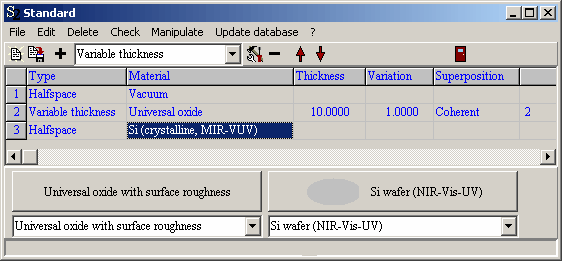This layer type was introduced for cases where the thickness of one layer in the stack is not homogeneous over the investigated sample spot, but varies due to some lateral gradient.
The algorithm used to compute the spectra is described in [Theiss 1997A]. It involves the Fourier transform of the layer thickness distribution function.
In the layer stack list objects of this type appear as follows:

Three parameters are to be set to define a layer of variable thickness. The average thickness, the thickness 'variation' and a third one which is an integer specifying the type of thickness distribution function. Whereas the first two parameters (thickness and variation specified in microns) appear as adjustable fit parameters, the latter is just a user-defined constant. In the dialog shown above type 2 has been chosen.
The following distribution functions are defined at present:
Distribution function type 1:

For a single 10 μm thick layer of a material with refractive index 1.5 one gets the following reflectance spectra:
Variation 0.1 μm:

Variation 0.5 μm:

Variation 1.0 μm:

Distribution function type 2:

Variation 0.1 μm:

Variation 0.5 μm:

Variation 1.0 μm:

What can be observed here is the transition from the coherent superposition of the partially reflected waves (from the front and end interface of the layer) at low wavenumbers to the incoherent superposition (no interference fringes) at high wavenumbers.
Warning: Layers of this type should not be combined with layers of type thick layer or simple layers with incoherent superposition!